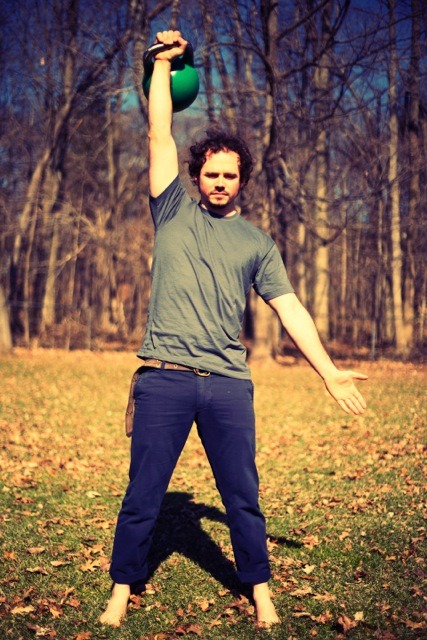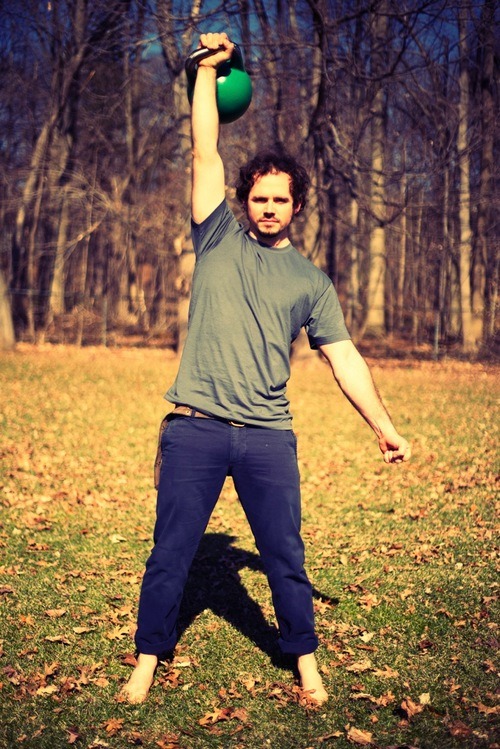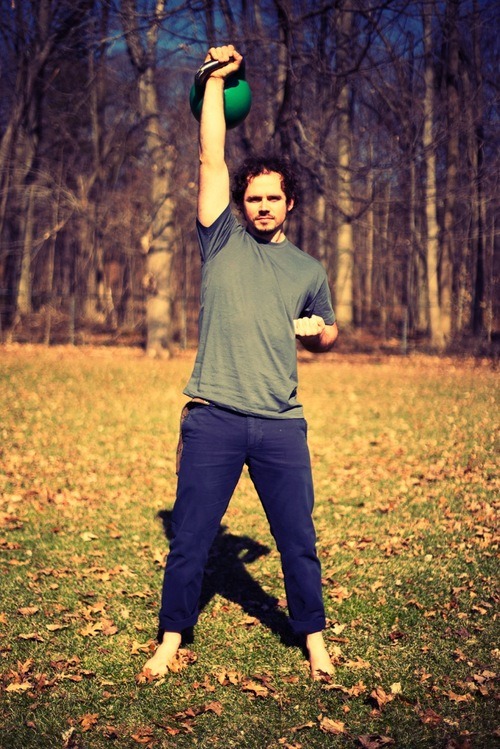THE ‘KI’ TO KETTLEBELL PRESSING POWER
Utilize internal energy to lift heavier weights,
do more reps, recover quicker and get better results
by Tom Maloney



Most information about kettlebell technique that exists today is focused on the biomechanical aspects of the many movements. However, what is not commonly known is how the management of internal energy, or what is called “qi” in Chinese culture (Ki, Jap.), affects a practitioner’s ability to lift heavier bells, do more reps, and recover more completely in between reps.
I am a black belt in a style of martial arts called Isshin Kempo that specializes in understanding how internal energy is manifested, cultivated, and managed through qi gong, kata, basic techniques, and sparring. Although my main focus has been on understanding internal energy within a martial arts context, my kettlebell experience has allowed me to realize that although the two disciplines share different techniques, the principles of energy management are the same. Whether the artist is throwing a straight punch in a heated sparring match or is on his last jerk rep in a Girevoy Sport biathlon, the benefit of learning how to manage qi is the same; more power.
In this article I will go into detail on how to properly utilize qi within the strict kettlebell military press. By “strict” I mean that the legs are taken out of the lift completely and do not aid in pressing the kettle bell overhead. This is opposite to a jerk where the legs are heavily involved.
There is a phrase in the world of strength training called “muscle irradiation.” This term is used to describe the action of tensing the muscles to increase a person’s strength in a given technique or lift. The goal of “muscle irradiation” is to have the muscles act as a relay system where the electrical current produced from one muscle’s intense contraction reaches the next and stimulates it enough to turn it “on.” An “on” muscle is a strong muscle. The added benefit of this technique is that strength gains are seen in muscles that are not directly used in a given lift. For example, to lift more weight during the military press; contract the glutes, tighten the anal sphincter, screw the feet into the ground, splay the toes, and squeeze the free hand as hard as possible. The amazing thing about “muscle irradiation”; it works.
However, I believe the explanations available only satisfy the biomechanical aspects as to why it works. By using the martial arts as a template upon which to understand internal energy, I have experienced that an individual can move his or her qi in two distinct ways. One way is by using the mind’s intent to literally “will” the qi to move. If the artist focuses on qi moving into his hand, then qi will move into his hand. This is assuming the artist’s concentration is strong enough, his intent (what the Chinese call “yi”) is clear enough, his mind is unobstructed by wandering emotions, his energy channels are not blocked, and that he has a good intuitive connection to his body’s subtler energy fields. Such sensitivity can only be accomplished through dedicated physical training and some understanding as to how energy moves through the meridians of the body.
The second way for a practitioner to move his energy is through physically altering his body position so as to forcibly push the qi into different channels. Qi will always move from a tensed muscle into a less tense muscle. By utilizing appropriate positioning and tension of the limbs he can create a system of internal “dams” or “gates” to siphon energy where he most needs it at the time. For example, if the left hand is outstretched by the side, made into a fist, and then squeezed as hard possible, energy leaves that forearm and instead travels upward into the relatively more relaxed biceps, triceps, and deltoids of the upper arm. Now, if that same left arm is tensed into a fist and instead placed into what most martial arts systems call the “chamber position,” then qi will flow into the torso and the right side of the body. Now the torso and the opposite right of the body contain more qi than they did when the left arm was outstretched with an open hand. A good analogy to describe this concept is to compare the body to a water balloon. When one end of a water balloon is squeezed, water rushes to the other side causing that side of the balloon to expand greatly. The water in the balloon is like the qi in the body and the “squeezing” action can be compared to how a practitioner positions his limbs. So, if a practitioner is doing a military press with his right arm, he will have more qi available with which to push the kettle bell overhead if he places his left arm in the “chamber position.”
Of course the best way for a practitioner to move his qi is to utilize both the mind and the body. For example, he physically places the left hand in the chamber position and is simultaneously mentally aware of the qi being squeezed into the right side of the body to assist in the overhead lift. If he places the left hand in the chamber position but is mentally thinking about something other than how his energy is moving, then the same amount of power will simply not be available. Likewise, if his mind is consciously aware of energy flowing to his pressing side but his opposite hand is not in the chamber, there will not be as much qi available.
I have personally found that by using the proper qi mechanics described above, I am consistently able to do 20% more reps for the military press. This number is a significant increase when it comes to a technique like the strict military press where most work sets are kept in the 5-10 rep range.
Just like all martial arts techniques, all kettle bell techniques have their own way of conducting the mind and the body to produce the most balanced, efficient, and powerful movement of qi possible.
Tom Maloney is a career martial arts teacher currently living in New Jersey
